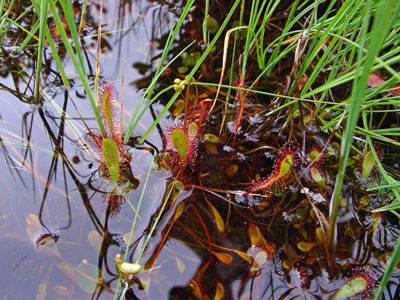DACF Home → Bureaus & Programs → Maine Natural Areas Program → Communities, Plants, and Animals → Rare Plants → Drosera anglica

Drosera anglica Huds.
English Sundew
- State Rank: S1
- Global Rank: G5
- State Status: Endangered
Habitat: Circumneutral fens and peaty areas. [Open wetland, not coastal nor rivershore (non-forested, wetland)]
Range: Circumpolar; Alaska to Northwest Territories, British Columbia to Quebec, Newfoundland to Labrador & Maine; Washington, California, Wyoming, Montana; Wisconsin to Michigan.
Aids to Identification: Drosera anglica resembles our common spatulate-leaf sundew (D. intermedia), and is closely related both to that and to the common round-leaf sundew (D. rotundifolia) as well as to the rare D. linearis. Like the spatulate-leaf sundew, the leaves are elongate oval and grow in a basal rosette, and have rows of sticky hairs on their surface, adapted for the insectivorous habit. D. anglica is best told from D. intermedia by the larger leaves (up to 5 cm long), the stiffer nature of the plant on the whole, the glandular hairs on the petioles, and the spindle-shaped rather than rounded-oval seeds.
Ecological characteristics: Drosera anglica is more widely distributed than D. linearis, and within its range is not as local. In Maine, however, the two are equally rare, occurring in the same location, and often together. Like D. linearis, D. anglica requires a very wet habitat with abundant calcium (lime). Like other sundew species, Drosera anglica is insectivorous; it receives part of its nutrients by capturing and digesting insects.
Phenology: A perennial or biennial; flowers in late July or August in Maine; seeds mature late summer
Family: Droseraceae
Synonyms: Drosera longifolia L.
Known Distribution in Maine: This rare plant has been documented from a total of 2 town(s) in the following county(ies): Aroostook
Reason(s) for rarity: Scarcity of suitable habitat, and disjunct from (south of) major portion of range.
Conservation considerations: Known populations are small, and subject to the vagaries of small populations like random fluctuations or localized disturbance events.